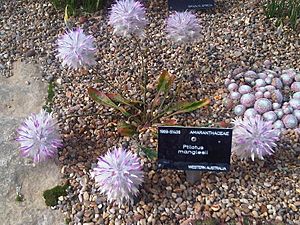Pom poms facts for kids
Quick facts for kids Pom poms |
|
|---|---|
 |
|
| Scientific classification | |
| Genus: |
Ptilotus
|
| Species: |
manglesii
|
Ptilotus manglesii, often called pom poms, is a small plant that grows naturally in Western Australia. The Noongar people, who are the traditional owners of the land, call this plant mulla mulla.
Contents
About the Pom Poms Plant
This plant is a type of herb. It usually grows low to the ground, but some can stand a bit taller. It can reach a height of about 0.05 to 0.3 meters (which is about 2 inches to 1 foot).
When it Flowers
The Ptilotus manglesii plant shows off its pretty pink flowers between September and January. These flowers look a bit like fluffy pom-poms, which is how the plant got its common name!
Where it Grows
You can find this plant in several areas of Western Australia. These include the Mid West, Wheatbelt, Peel, and South West regions. It likes to grow in sandy or gravelly soils.
How the Plant Got its Name
The Ptilotus manglesii plant has had a few different scientific names over time.
Early Discoveries
The first time this plant was officially described was in 1810. A botanist named Robert Brown gave it the name Trichinium macrocephalum. He wrote about it in a book called Prodromus Florae Novae Hollandiae.
Name Changes
Later, in 1839, another botanist named John Lindley changed its name to Trichinium manglesii. Then, in 1868, Ferdinand von Mueller reclassified it. He gave it the name we use today: Ptilotus manglesii. This new name was published in his work called Fragmenta Phytographiae Australiae.
Images for kids
-
A pair of cheerleading pom-poms
-
Cheerleaders using pom-poms during an American football halftime show
-
Shako dating from the Bourbon Restoration with a red company pompon







